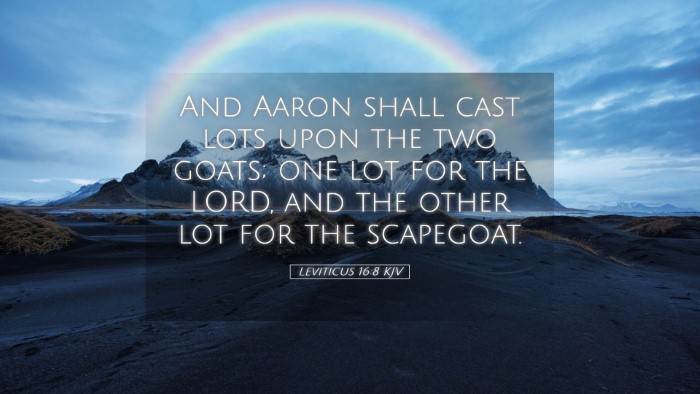Commentary on Leviticus 16:8
Bible Verse: “And Aaron shall cast lots upon the two goats; one lot for the Lord, and the other lot for the scapegoat.” (Leviticus 16:8)
Introduction
The passage in Leviticus 16:8 introduces one of the most significant rituals in the ancient Israelite Day of Atonement, involving the casting of lots for two goats. This ceremony conceptually bridges the notion of sin offering and the forgiveness and removal of sin. Various commentaries shed light on its theological implications, ritual practices, and the character of God as revealed through these rites.
Theological Overview
This verse encapsulates the dual purpose of the goats: one serves as a sacrifice to the Lord, atoning for the sins of the people, while the other, known as the scapegoat, symbolically carries away the sins into the wilderness.
Matthew Henry’s Commentary
Matthew Henry emphasizes the importance of drawing lots as a means of divine decision-making. He notes that this practice illustrates God's sovereign choice in atonement processes, underscoring the holiness surrounding the Day of Atonement. In his analysis, Henry suggests that the goat for the Lord represents satisfaction for God’s justice, while the scapegoat signifies God's mercy as it is driven away from the community, symbolically carrying sin far from them.
Albert Barnes’ Commentary
Albert Barnes provides insight into the ritualistic aspects of Leviticus 16:8, detailing the function of the goats within the socio-religious structure of Israel. He remarks that casting lots serves to involve God's will explicitly, reminding the Israelites of His omnipotence in judgment and grace. Barnes interprets the scapegoat as a profound symbol of Christ - taking upon Himself the sins of the world and bearing them away, thus providing a prefiguration of the ultimate sacrifice that would fulfill this atonement.
Adam Clarke’s Commentary
Adam Clarke delves deeper into the cultural context, supporting the notion that the casting of lots was a common practice to ensure impartiality and highlight divine direction. He assesses the significance of the goats, explicating that the 'lot for the Lord' represents sacrificial obligation, while the 'scapegoat' signifies release and rejuvenation of the community. Clarke remarks on the nuanced portrayal of God as both just and merciful, emphasizing the relational aspect of atonement whereby God actively engages with His people’s sinfulness.
Symbolic Representation
Both goats encapsulate crucial dynamics of sin and forgiveness:
- Goat for the Lord: Represents sin-bearing and atonement, emphasizing the gravity of sin and the necessity for sacrifice.
- Scapegoat: Illustrates the removal of sin and its implications for community purity; it personifies separation from sin and cleansing.
The Role of Atonement
The ritualistic act of atonement portrayed in Leviticus 16:8 serves multiple purposes in both historical and contemporary contexts:
- Recognition of Sin: The act of casting lots serves to acknowledge the communal nature of sin.
- Divine Sovereignty: By allowing God to choose which goat bears the sins, it asserts human dependence on divine guidance for forgiveness.
- Hope and Restoration: The scapegoat epitomizes hope, presenting an image of restoration as sins are carried away from the community.
Practical Applications for Pastors and Theologians
The insights from Leviticus 16:8 can have profound applications for modern pastoral care and theological reflection:
- Preaching on Sin and Redemption: This passage encourages sermons that illuminate the gravity of sin while emphasizing God's mercy and redemptive work.
- Encouraging Religious Rituals: Understanding the significance of rites fosters practices that enhance the spiritual experience of atonement within the church.
- Analyses of Christology: Leviticus 16:8 paves the way for understanding Christ’s role as both our ultimate sacrifice and the one who releases us from sin.
- Encouragement for Community Repentance: The communal aspect of sin in this scripture is a rallying point for fostering collective confession and repentance in congregations.
Conclusion
Leviticus 16:8 offers rich theological insights that resonate through the practices of ancient Israel and into the New Testament revelation in Jesus Christ. The dual aspects of atonement and forgiveness articulated in this verse reveal the profound wisdom of God in dealing with human sinfulness. Understanding these elements is essential for biblical scholars, students, and pastors seeking to deepen their grasp of God's character and the gospel narrative.


